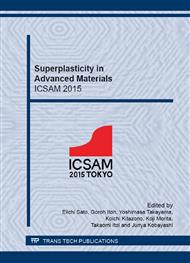[1]
P. Ward Flynn, J. Mote, J. E. Dorn, On the thermally activated mechanism of prismatic slip in magnesium single crystals, Trans. AIME 221 (1961) 1148-1154.
Google Scholar
[2]
G. I. Taylor, Plastic strain in metals, J. Inst. Metals 62 (1938) 307-324.
Google Scholar
[3]
E. W. Kelley, W. F. Hosford, Jr., Plane-strain compression of magnesium and magnesium alloy crystals, Trans. AIME 242 (1968) 5-13.
Google Scholar
[4]
A. R. Antoniswamy, E. M. Taleff, L. G. Hector, Jr., J. T. Carter, Plastic deformation and ductility of magnesium AZ31B-H24 alloy sheet from 22 to 450 �C, Mater. Sci. Engnrg. A 631 (2015) 1-9.
DOI: 10.1016/j.msea.2015.02.018
Google Scholar
[5]
B. Hutchinson, M. R. Barnett, A. Ghaderi, P. Cizek, I. Sabirov, Deformation modes and anistropy in magnesium alloys AZ31, Inter. J. Mater. Res. (Z. Metall. ) 100 (2009) 556-563.
DOI: 10.3139/146.110070
Google Scholar
[6]
N. Stanford and P. S. Sotoudeh, K. Bate, Deformation mechanisms and plastic anisotropy in magnesium alloy AZ31, Acta Mater. 5 (2011) 4866-4874.
DOI: 10.1016/j.actamat.2011.04.028
Google Scholar
[7]
J. Min, Y. Cao, J. T. Carter, R. Verma, Comparison of tensile properties and crystallographic textures of three magnesium alloy sheets, in: S. N. Mathaudhu, W. H. Sillekens, N. R. Neelameggham, N. Hort (Eds. ) Magnesium Technology 2012, TMS/Wiley, Warrendale, PA, 2012, pp.355-360.
DOI: 10.1002/9781118359228.ch65
Google Scholar
[8]
http: /www. aist. go. jp/aist_e/latest_research/2010/20100217/20100217. html.
Google Scholar
[9]
ASTM International, Standard test methods for determining average grain size, Standard Designation E 112-96, ASTM International, West Conshohocken, PA, July (1996).
Google Scholar
[10]
W. Köster, Die temperaturabhängigkeit des elastizitätsmoduls reiner metalle, Z. Metall. 39 (1948) 1-9.
Google Scholar
[11]
C. R. Barrett, A. J. Ardell, O. D. Sherby, Influence of modulus on the temperature dependence of the activation energy for creep at high temperatures, Trans. AIME 230 (1964) 200-204.
Google Scholar
[12]
O. D. Sherby, P. M. Burke, Mechanical behavior of crystalline solids at elevated temperature, Prog. Mater. Sci. 13 (1968) 325-390.
Google Scholar
[13]
C. Zener, J. H. Hollomon, Effect of strain rate upon plastic flow of steel, J. Appl. Phy. 15 (1944) 22-32.
DOI: 10.1063/1.1707363
Google Scholar


